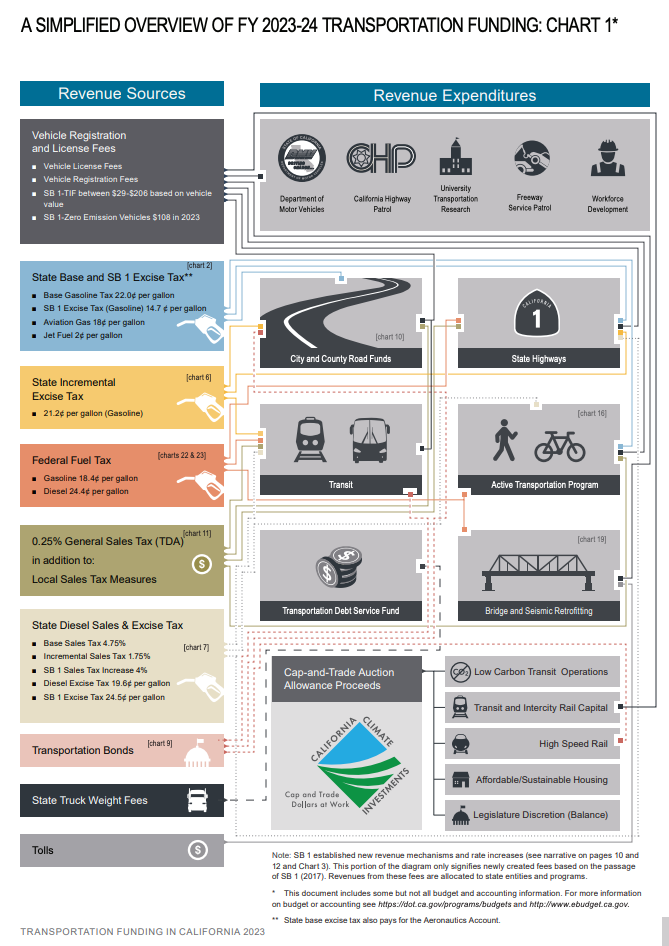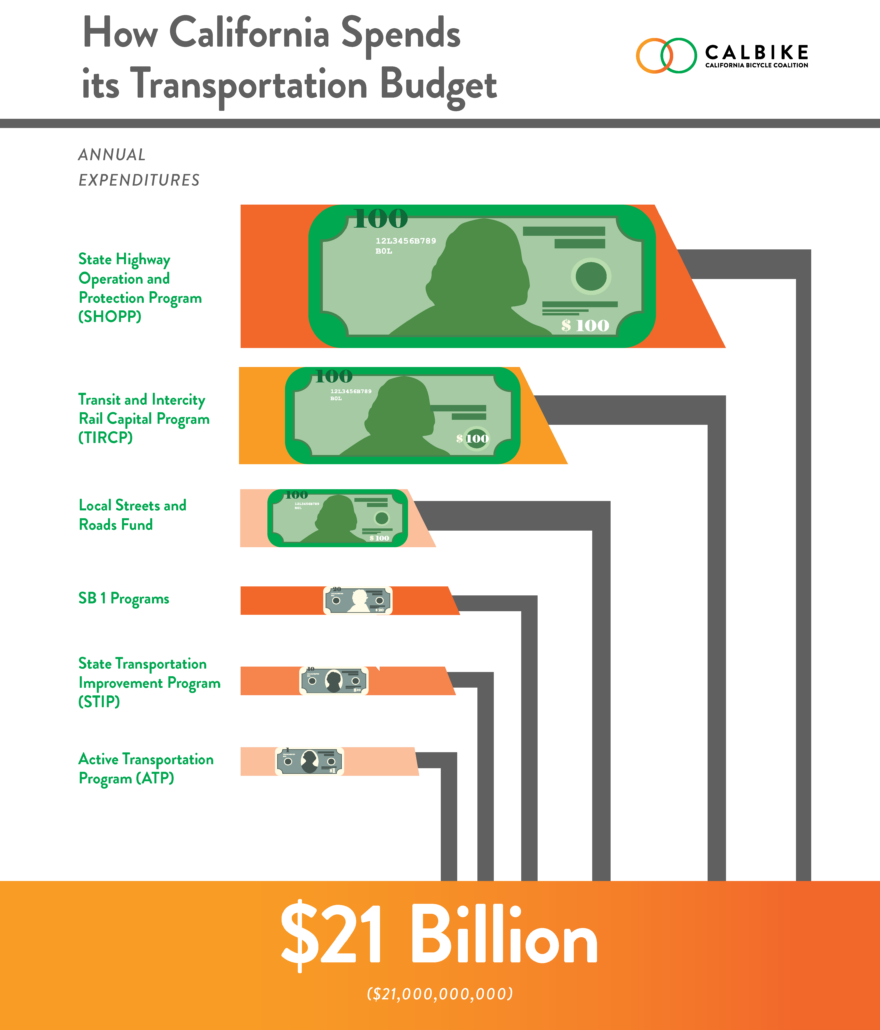There Is No Deficit in California’s Transportation Budget
As California begins negotiations for its 2024-2025 budget, much of the talk will center on a projected $38 billion shortfall. In past years, Governor Gavin Newsom has used budget deficits as reasons to veto active transportation bills. In 2023, the governor initially took back half of the extra $1.05 billion allocated to the Active Transportation Program (ATP) in a surplus year, though that money was later returned. And, to be clear, the “extra” funding still wasn’t enough to greenlight all the worthy projects in the chronically underfunded and urgently needed program.
The governor’s proposed 2024-2025 budget once again takes money from the ATP while leaving freeway spending untouched.
We need to spend more, not less, on active transportation and, although California will need to make some hard choices due to the budget shortfall this year, there is no deficit in the transportation budget. There is more money in the transportation coffers than there has ever been.
State revenue for transportation has soared with the passage of SB 1 in 2017. SB 1 expanded funding for California’s transportation system by an average of $5.4 billion annually. Now, the Infrastructure Investment and Jobs Act (IIJA), passed in 2021, is sending federal cash to California. The IIJA will bring California an estimated $41.9 billion over five years from Federal Fiscal Year (FFY) 2022 through FFY 2026. If you compare the 2017-2018 transportation budget with that of 2023-2024, the additional money available for transportation infrastructure is clear:
- $13 billion in state funds (2017-18)
- $21 billion in state funds (2023-24)
- $6 billion in federal funds (2017-18)
- $12 billion in federal funds (2023-24)
Totals:
- $19 billion in state & federal funds (2017-18)
- $33 billion in state & federal funds (2023-24)
State Transportation Budget Demystified
Given how transportation funds are raised, the transportation budget is self-generating (user taxes and fees) and generally immune from the stark deficits found in the whole of California’s budget, which is significantly dependent on income taxes and facing a $68 billion deficit this coming year.
The entire state budget from last year was almost $300 billion. The transportation budget represented 7% of that: $21 billion.

Chart from TRANSPORTATION FUNDING IN CALIFORNIA 2023.
The governor and legislature dictate how state revenues are spent on the transportation network. The legislature appropriates state funding for specific purposes each year. Below are the main programs according to the 2023-24 budget year.

Dwindling gas taxes shouldn’t mean active transportation spending dries up
In December 2023, the California Legislative Analyst Office (LAO) issued a report on the future of transportation funding as more people move to electric vehicles and state gas tax revenues decline. This could pose a threat to the ATP, which receives most of its funding from gasoline taxes. But it shouldn’t.
The LAO report estimated that California’s funding from gas taxes will drop by over $4 billion in the next decade due to the state’s switch from gas- to electric-powered vehicles, about a third of that amount.
Six years after the passage of Senate Bill 1, the Road Repair and Accountability Act of 2017, California needs to draft a new mega-transportation bill. Rather than using the decline in gas purchases as an excuse to cut funding for the active transportation infrastructure we urgently need to complete the transition from fossil fuels, California must find sustainable funding sources to drive our transportation system.
State leaders were aware of this problem when SB 1 was being negotiated in 2016-2017, so they included a new tax on zero-emission vehicle owners called the “Road Improvement Fee.” The fee charges electric vehicle owners an annual flat $100 that is adjusted for inflation. The adjusted rate for the calendar year 2023 is $108. This fee only applies to electric vehicles with the model year 2020 or later.
The road improvement fee helps to offset the decline in gas tax revenue, but, as the LAO report suggests, California will have to find new funding sources or reduce its transportation spending. The solution may be to do some of both.
California can build an excellent transportation system that serves the needs of residents. The LAO report’s focus on highway maintenance and rehabilitation programs ignores the billions that go to capacity expansion for motor vehicles. Eliminating the short- and long-term costs of expanding freeway capacity, including canceling projects currently in the pipeline that have not begun construction, would immediately free up millions of dollars for Complete Streets, public transportation, and even deficit reduction. At the same time, this shift will help California get on track with its GHG reduction goals — goals impossible to meet if we keep building new freeway capacity.
Revenue decline will be slower than predicted
LAO bases its analysis on ARB’s Scoping Plan. As a recent NRDC analysis showed, the state is not even close to reaching the ambitious goals laid out in that plan. To use it as the foundation for analysis is inaccurate as it does not reflect the current policy reality. For example, the scoping plan sets VMT reduction goals that California isn’t meeting. In fact, the reverse is happening: VMT has soared in recent years, filling transportation coffers with gas tax revenue.
ZEV sales have increased from 4% of all new vehicle sales in 2017 to 25% in 2023. However promising sales of new ZEVs are in California, ZEVs still only make up about 3% of all light-duty cars on the road. Dirty heavy-duty trucks, buses, and vans are hardly transitioning to electric. While this is bad news for the environment, it leaves diesel tax revenue mostly steady for years to come. In reality, the decline in gas and diesel use will be much slower than the LAO posits.
A People-First Mobility Budget
In the coming days, CalBike will propose a People-First Mobility Budget that realigns California’s transportation spending to projects that provide more mobility options, healthier neighborhoods, more equitable transportation, and fewer harmful tailpipe emissions.
California can and should change its road-building priorities from expensive, climate-killing freeways and wide local thruways for cars and trucks. Complete Streets that accommodate all modes of transportation are cheaper to build, more economical to operate, and improve health and mobility for our state’s residents. We need a transportation budget plan that supports sustainable modes and a vision for the future. Our budget proposal will do just that.





